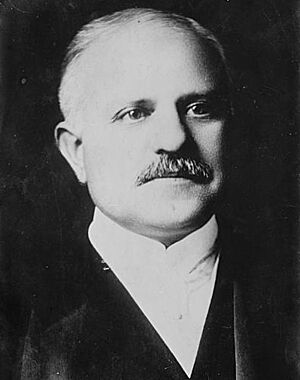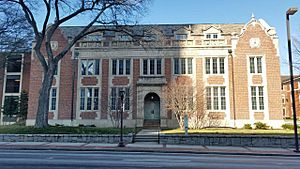Daniel Guggenheim facts for kids
Quick facts for kids
Daniel Guggenheim
|
|
|---|---|

1925 photo
|
|
| Born | July 9, 1856 |
| Died | September 28, 1930 (aged 74) |
| Alma mater | Peirce College |
| Known for | Battle for control of ASARCO Daniel Guggenheim Medal |
| Spouse(s) | Florence Shloss |
| Children | Meyer Robert Guggenheim Harry Guggenheim Gladys Eleanor Guggenheim |
| Parent(s) | Meyer Guggenheim Barbara Guggenheim |
Daniel Guggenheim (born July 9, 1856 – died September 28, 1930) was an important American businessman who led many mining companies. He was also a philanthropist, meaning he gave a lot of money to good causes. Daniel was a son of Meyer Guggenheim and Barbara Guggenheim. By 1910, he was in charge of the world's biggest group of mining businesses.
He later retired in 1922 and focused on helping to develop aviation (flying). Daniel helped create new ways of doing business and was known for good relationships with workers. He also played a big part in the early days of airplanes and rockets.
Contents
Daniel Guggenheim's Early Life and Business
Daniel Guggenheim was born and grew up in Philadelphia. His father, Meyer Guggenheim, was from a Jewish family. When Daniel was young, he went to Switzerland to learn about the lace and embroidery business. He also bought goods for his father's company.
In 1881, a big discovery of valuable silver and lead ore happened in the Guggenheim mines in Leadville, Colorado. This discovery became the start of the Guggenheim family's huge wealth from mining. In 1884, Daniel came back to the United States to help manage the family's fast-growing mining and metal processing businesses. Daniel helped set up the Guggenheim mining and smelting business in Mexico. By 1895, this part of the business was making $1 million a year in profit.
Taking Control of the Mining Industry
In 1891, Daniel's father, Meyer, brought together about twelve of the family's mining operations. He formed a company called the Colorado Smelting and Refining Company. The Guggenheim family then began a long competition with the American Smelting and Refining Company (ASARCO). This company was supported by the powerful Rockefeller family.
By 1901, the Guggenheims had taken charge of ASARCO. They became the main leaders in the mining industry for the next thirty years. Daniel was named the top boss of ASARCO's board of directors. He managed this large group of companies until 1919.
After his father died in 1905, Daniel took over all the Guggenheim family businesses. Through ASARCO, Kennecott Copper, and other family companies, the Guggenheims mined many different metals. They mined tin in Bolivia, gold in the Yukon, and copper in Alaska, Utah, and Chile. They also mined diamonds and rubber in the Belgian Congo and diamonds in Angola. Daniel Guggenheim's business decisions had a big impact on whole countries. His biographer, John H. Davis, wrote that Daniel was so powerful he "could make or break a government with a telegram." Daniel was very determined and wanted to be in charge.
By 1918, the family's total wealth was thought to be between $250 million and $300 million. This made them among the richest people in the world. Daniel was also a member of the National Security League. This group played a role in moving the USA, which was neutral at the time, into World War I.
Retirement from Mining
By 1922, disagreements within the family became very strong. The older Guggenheim brothers were accused of using ASARCO, which they controlled, to benefit their own family business, Guggenheim Brothers. Because of this, the ASARCO board voted the brothers out of control. After other family disagreements and business problems, Daniel retired in 1923 when he was 67 years old.
Daniel Guggenheim's Personal Life
On July 22, 1884, Daniel married Florence Shloss. They had three children: Meyer Robert Guggenheim, Harry Frank Guggenheim, and Gladys Eleanor Guggenheim Straus. Daniel Guggenheim passed away on September 28, 1930, at his large home, Hempstead House, in Port Washington, New York. He was 74 years old.
Supporting Aviation
During World War I, Daniel's son, Harry Guggenheim, became a pilot. Both Daniel and Harry became strong supporters of aviation technology (anything to do with flying). In the 1920s, they created the Daniel Guggenheim Medal. This award recognized important achievements in aeronautics, which is the science of flight.
They also provided money through the Daniel Guggenheim Fund for the Promotion of Aeronautics. This fund gave grants for research into flight at many universities. These included the California Institute of Technology, Princeton University, Georgia Institute of Technology, Harvard University, and the Massachusetts Institute of Technology. The money helped create special aviation labs at Caltech and Princeton.
In 1927, Daniel offered a main prize of $100,000 and five smaller prizes of $10,000 for the "Guggenheim Safe Aircraft Competition." This competition challenged aircraft designers to build safer planes. The planes had to be stable in rough air, land in 500 feet, and take off in 300 feet over a 35-foot obstacle. They also needed to fly slowly, at 35 miles per hour, and even at 38 miles per hour with the engine off.
Fifteen aircraft entered the competition, but only two met all the rules: the American Curtiss Tanager and the British Handley Page Gugnunc. The Curtiss Tanager was chosen as the winner. Even though neither of these planes was mass-produced, the competition greatly influenced designers to build safer aircraft in the future.
Impact in Alaska
Daniel Guggenheim also caused some debate in Alaska starting in 1906. Stephen Birch, a wealthy miner who wanted to develop Alaska's resources and railroads, asked Guggenheim for money to help with his copper mining claims. Daniel and his brother made a "gentlemen's agreement" with Birch to form the Alaska Syndicate. This group bought almost half of Birch's company stock and all the stock in the Copper River and Northwestern Railway.
All of this led to an "anti-Guggenheim" movement in Alaska. This movement played a big role in the political elections and appointments in Alaska in 1908.
See also
 In Spanish: Daniel Guggenheim para niños
In Spanish: Daniel Guggenheim para niños
- Guggenheim family



